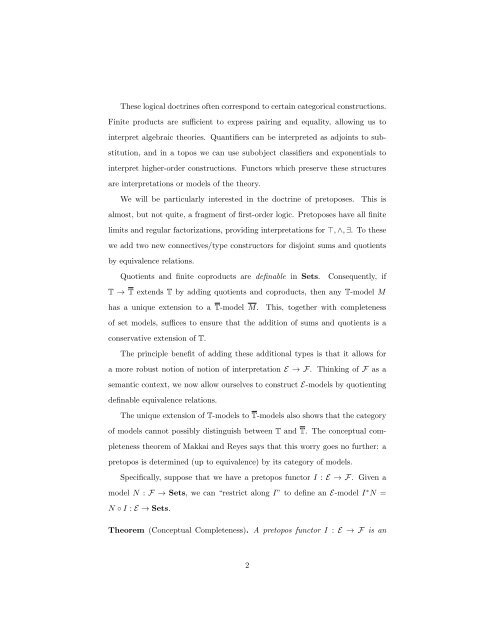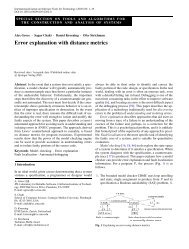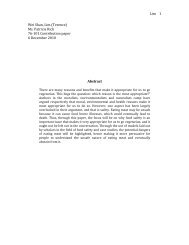A refactored proof of conceptual completeness
A refactored proof of conceptual completeness
A refactored proof of conceptual completeness
You also want an ePaper? Increase the reach of your titles
YUMPU automatically turns print PDFs into web optimized ePapers that Google loves.
These logical doctrines <strong>of</strong>ten correspond to certain categorical constructions.<br />
Finite products are sufficient to express pairing and equality, allowing us to<br />
interpret algebraic theories. Quantifiers can be interpreted as adjoints to sub-<br />
stitution, and in a topos we can use subobject classifiers and exponentials to<br />
interpret higher-order constructions. Functors which preserve these structures<br />
are interpretations or models <strong>of</strong> the theory.<br />
We will be particularly interested in the doctrine <strong>of</strong> pretoposes. This is<br />
almost, but not quite, a fragment <strong>of</strong> first-order logic. Pretoposes have all finite<br />
limits and regular factorizations, providing interpretations for ⊤, ∧, ∃. To these<br />
we add two new connectives/type constructors for disjoint sums and quotients<br />
by equivalence relations.<br />
Quotients and finite coproducts are definable in Sets. Consequently, if<br />
T → T extends T by adding quotients and coproducts, then any T-model M<br />
has a unique extension to a T-model M. This, together with <strong>completeness</strong><br />
<strong>of</strong> set models, suffices to ensure that the addition <strong>of</strong> sums and quotients is a<br />
conservative extension <strong>of</strong> T.<br />
The principle benefit <strong>of</strong> adding these additional types is that it allows for<br />
a more robust notion <strong>of</strong> notion <strong>of</strong> interpretation E → F. Thinking <strong>of</strong> F as a<br />
semantic context, we now allow ourselves to construct E-models by quotienting<br />
definable equivalence relations.<br />
The unique extension <strong>of</strong> T-models to T-models also shows that the category<br />
<strong>of</strong> models cannot possibly distinguish between T and T. The <strong>conceptual</strong> com-<br />
pleteness theorem <strong>of</strong> Makkai and Reyes says that this worry goes no further: a<br />
pretopos is determined (up to equivalence) by its category <strong>of</strong> models.<br />
Specifically, suppose that we have a pretopos functor I : E → F. Given a<br />
model N : F → Sets, we can “restrict along I” to define an E-model I ∗ N =<br />
N ◦ I : E → Sets.<br />
Theorem (Conceptual Completeness). A pretopos functor I : E → F is an<br />
2








